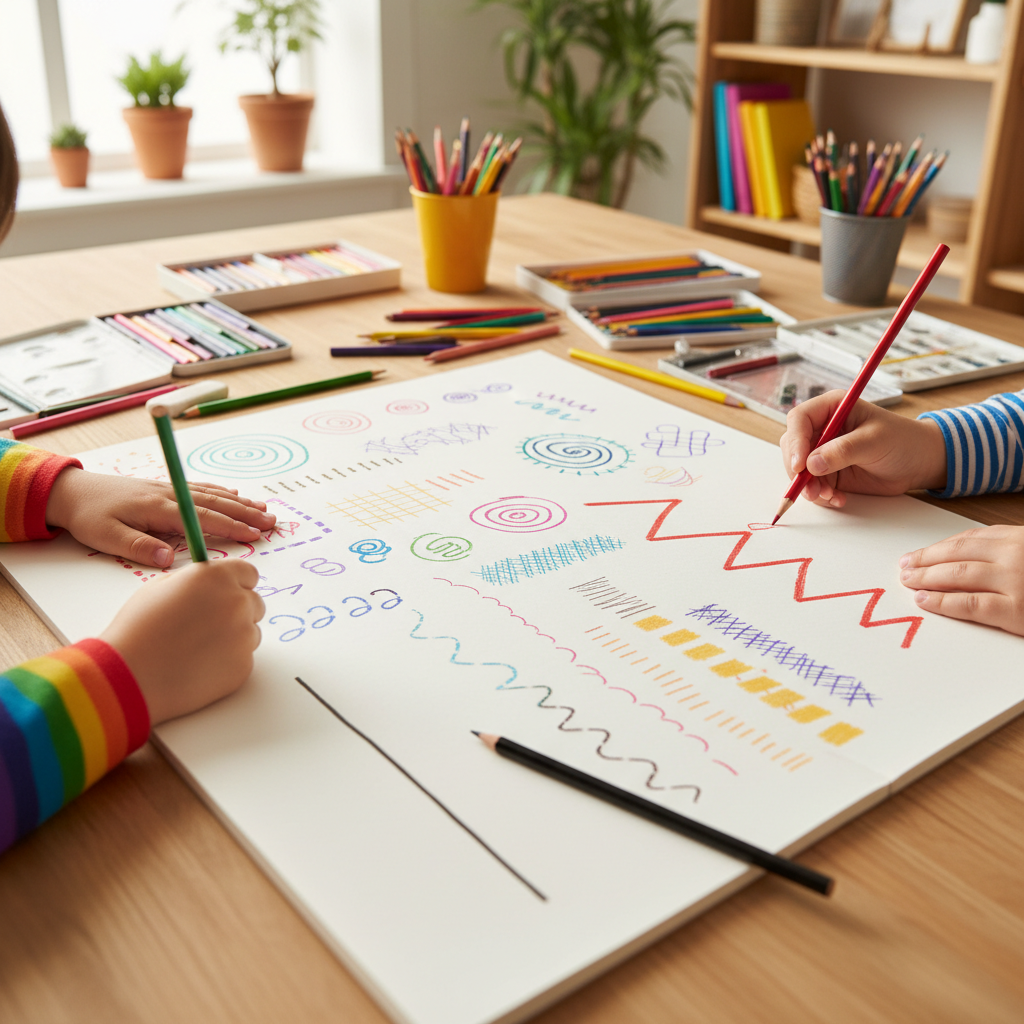Use different pencil lines in a drawing
Create a drawing using different pencil lines: thin, thick, light, dark, hatching, and crosshatching to show texture, depth, and shape.



Step-by-step guide to create a drawing using different pencil lines
Step 1
Gather your materials and clear a flat workspace to draw on.
Step 2
Choose one simple subject to draw like an apple a leaf or a shoe.
Step 3
Lightly sketch the basic shapes of your subject with the HB pencil.
Step 4
Use light pressure with the HB pencil to draw thin clean outline lines.
Step 5
Make thicker bolder outlines on areas that should look strong or closer by pressing a bit harder or using a softer pencil like 2B.
Step 6
Add light shading to flat areas with gentle even strokes to show smooth surfaces.
Step 7
Add darker shading in shadowed areas using heavier pressure or the 4B pencil to create depth.
Step 8
Create texture by drawing hatching: many parallel lines spaced close or far apart depending on how dark you want the area.
Step 9
Make areas even darker and more textured by adding crosshatching: draw another set of parallel lines that cross the first set.
Step 10
Use the eraser to lift tiny highlights where light hits your subject to increase contrast.
Step 11
Look over your drawing and add small thin or thick line adjustments to balance shape texture and depth.
Step 12
Share your finished drawing on DIY.org
Final steps
You're almost there! Complete all the steps, bring your creation to life, post it, and conquer the challenge!


Help!?
What can we use if we don’t have HB, 2B, or 4B pencils or a kneaded eraser?
If you don't have HB, 2B, or 4B pencils, use a regular pencil pressed lightly for HB effects and pressed harder for darker marks, substitute a soft charcoal pencil for 2B/4B tones, and use any clean white or kneaded eraser to lift the tiny highlights described in the eraser step.
My shading looks blotchy and my outlines aren't clean — how can I fix that?
Keep your HB pencil pressure light for thin clean outline lines as instructed, practice even gentle strokes for light shading, rest your hand on a scrap piece of paper to avoid smudging, and tidy problem areas with the eraser to lift highlights or soften edges.
How can I adapt this activity for different ages or skill levels?
For younger kids simplify by choosing an easy subject, using thicker pencils or crayons for bold outlines and only light shading, while older children can follow all steps including 2B/4B shading, hatching, crosshatching, and fine line adjustments to build texture and depth.
What are some ways to extend or personalize the drawing once it's finished?
Extend the activity by creating a series of the same subject with different line weights and light directions, adding colored pencil over the shaded areas, or photographing and sharing the finished drawing on DIY.org as suggested.
Watch videos on how to create a drawing using different pencil lines
How to Draw Lines
Facts about pencil drawing techniques for kids
✏️ The word "pencil" comes from the Latin penicillus, meaning "little tail" — it originally referred to small brushes used for detailed marks.
🎨 Hatching and cross-hatching were widely used by Renaissance artists like Albrecht Dürer to create shading, texture, and three-dimensional form with just lines.
🪨 Large graphite deposits in Borrowdale, England, were discovered in the 1500s and led to early use of solid graphite sticks for writing and drawing.
🔢 Pencils are graded on an H–B scale (hard to soft); artists choose harder H pencils for light lines and softer B pencils for dark, rich strokes.
👀 Thicker and darker lines often read as closer to the viewer while thinner, lighter lines appear farther away — a simple trick to suggest depth.
How do I teach my child to create a drawing using different pencil lines?
What materials do I need to practice different pencil lines with my child?
What ages is a pencil line and hatching drawing activity suitable for?
What are the benefits of practicing different pencil lines and hatching?


One subscription, many ways to play and learn.
Only $6.99 after trial. No credit card required



